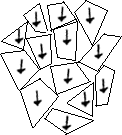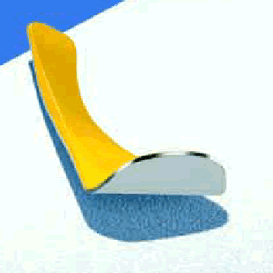The Olympic Winter Games - Design and Technology
Smart skis: new technology and new materials for the best skis
1. In this page you will find information on smart skis: what do you know about them?
2. Try to find out what your fellow students already know about the topic. Then compare your information to the following text.
- What are smart skis?
Smart skis incorporate vibration control technology. When skiing at high speeds and on tough terrain, skis tend to vibrate, lessening the contact area between the ski edge and the snow surface. This results in reduced stability and control and decreases the skier's speed. The technology employed by smart skis overcomes these limitations by utilizing a clever design and the integration of piezoelectric sensors and an actuator control system. The piezoelectric ceramics embedded in the ski convert the unwanted vibrations into electric energy, thus keeping the skis on the snow. These skis perform well in all conditions (in hard and soft snow).
2. How do you think smart skis work? Discuss with your fellow students and then compare your answers to the following explanation.
Smart skis employ piezoelectric materials which act both as sensors and actuators.
A dampening unit, consisting of a small card made of a piezoelectric lead-based ceramic, is placed directly where vibrations tend to originate, which is around a point just in front of the binding that anchors the skier's feet. The ceramic card also contains an electronic control circuit that acts as the smart ski's "brain". When the piezoelectric elements detect vibration, they send an electric signal to the control circuit, which then in turn sends pulses of electric energy into the piezoelectric material to change its stiffness and damp the unwanted vibrations. The ceramics act as mechanical actuators and move in opposition, quickly cancelling vibrations out.
- What are piezoelectric materials?
Piezoelectricity was discovered through experiments with quartz done by Jacques and Pierre Curie in the 1880s.
Piezoelectric materials can turn mechanical energy into electric energy and vice versa. This means that they produce an electric field when exposed to a change in dimension caused by an imposed mechanical force (piezoelectric or generator effect). Conversely, an applied electric field will produce a mechanical stress (electrostrictive or motor effect).
The stress is very small, 0.1-0.3%. They are used for sensing purposes (e.g. microphone, transducer), and for actuating applications.
Similar to piezoelectric materials are electrostrictive and magnetostrictive materials used in high precision actuation. They are ferromagnetic materials which experience an elastic strain when subjected to an electric or magnetic field respectively.
- How do piezoelectric materials work?
Piezoelectric materials have two crystalline configurations. One structure is organized, while the other is not. Organization of the structure has to do with polarization of the molecules that make up the material. A non-polarized material has a non-organized structure from the electrical point of view, while the polarized material is organized. To polarize the material, voltage or electricity must be conducted through it. As a result of this electrical input, the molecules of the material reorient themselves, thus changing the shape of the material; this is called electrostriction. Similarly, if mechanical force is exerted on the material to change its shape, an electric field is produced; this is called piezoelectric effect. Electrostriction and piezoelectric effect are opposite phenomena.
The pictures below show this process at a microscopic level.
Non-polarized material: |
Polarized material: |
 |
 |
The input of shape change produces electricity |
The input of electricity produces a change in shape |
Features of piezoelectric materials:
- shape change in response to electricity;
- production of an electric charge when subjected to a mechanical stress (e.g. compression, vibration, shock);
- ability to move hundreds of pounds, with no friction and hence no wear and tear on the material;
- good performance in a wide variety of conditions, including both high and low temperatures, temperature changes and even within a vacuum.
Examples of piezoelectric materials:
• quartz
• tourmaline
• barium titanate
• cadmium sulfide
• lead zirconate titanate (PZT)
• piezoelectric polymers (PVDF, PVC)
Applications:
• cigarette lighters;
• piezoceramic motors used to cancel out vibrations/sound in automobiles and airplanes through counteraction;
• devices installed on the trailing edge of helicopter blades to damp vibrations in helicopter rotors;
• piezos embedded in sporting equipment such as tennis racquets, snowboards, baseball bats and golf clubs to dampen vibrations.
3. Can you think of other possible applications of piezoelectric materials besides the ones mentioned above? Give reasons accounting for your suggestions.
- Why was Smart Ski Technology™ developed?
Skis may seem to be simple products, but, on the contrary, the ski manufacturing process is extremely complicated.
Different skiing conditions require skis of different shapes and sizes, made of different materials:
Shapes |
Pros |
Cons |
Longer skis |
provide greater stability and allow better control at high speed, because more of the ski is in contact with the snow at all times |
harder to manoeuvre |
Shorter skis |
easier to turn and control |
less stable |
Wider skis |
ride better on soft, powdery snow because they spread the skier's weight over a larger area |
less fast |
Hourglass-shaped skis with a large sidecut |
turn better on hard snow and ice because they concentrate more of the skier's weight on the blade edge at the middle of the ski, allowing it to dig deeper and make sharper cuts |
|
During the past century the modern ski manufacturing industry started to look for a unique shape, a versatile ski that could ride well in any set of conditions. The result was a wider, shorter hourglass-shaped ski, which allows the skier to carve more easily and make sharper turns. However, wider designs also create more surface area and, as a result, the skis are subjected to more torsion forces and twisting which can cause the edge to loose contact with the snow. Especially on uneven or hard snow surfaces skis tend to vibrate: this reduces a skier's ability to turn, stop and overall control.
Unpredictable vibrations are also caused by reactionary forces between a rider's skis and the snow: these forces are constantly being varied by a number of factors ranging from snow softness to a skier's motions and actions. Tests showed that the majority of vibrations are concentrated in the area of the ski binding and propagate outwards to the rest of the ski. Scientists and engineers went on researching every possible solution to their vibration problem until they found a revolutionary one.
- When and where was this innovative technology born?
ACX and K2 : the Piezoelectric Solution
Active Control eXperts (ACX), a company in Cambridge, Massachusetts, specialised in piezoelectric materials and their use in various "smart" structures, teamed up with K2, American manufacturer of alpine skis, to develop the smart skis. The K2 Four, the first ski with a brain, appeared on the US market in December 1995. The same technology was applied to mountain bikes and was used to prevent flutter in the carbon-fibre rudders of the F/A18 Tomcat navy fighter.
The history of the Vashon Island firm K2 has all the elements of an American business legend: modest beginnings, rapid growth and excellent products with a worldwide reputation. Its founder, Bill Kirschner, invented the fibreglass ski in 1961. Later on the company grew to become one of the snowboard and inline skate market leaders. More recently, K2 launched the latest evolution of their award-winning damping technology, the innovative MOD technology™, which utilizes a Binary Core Construction. An elastomeric secondary core is placed atop a traditional ski construction and works as a high performance suspension system and mass damper. With the advent of the MOD structure, K2 designer Anthony DeRocco discovered that the piezoelectric device that had been a K2 technology staple for about six years was redundant. MOD construction by itself dampened vibrations as well as the old wired ceramic chip.

K-2's Axis ST
Head's Intelligence™Technology
After trying the material in tennis racquets, Head, another American leader in sports equipment, adapted its "Intellifibers" – made of piezoelectric material - into ski construction. These fibres are located just in front of the binding, the critical point of the ski from which they can influence the front part of the ski in the most effective way. The Intellifibers are placed at a 45-degree angle in the ski for maximum exposure to torsion forces when the skier makes a turn. These forces increase with speed and on hard snow. Intelligence skis sense any change of snow, speed or terrain and adapt to it. The electric energy generated by the Intellifibers is sent to a microchip embedded in the ski. There it is amplified and sent back to the Intellifibers which straighten instantly increasing the stability of the ski. This all happens in 5 milliseconds.
 |
 |
Traditional ski |
Head Intelligence ski with Intellifibers |
4. Can you explain why these skis are called “smart”? Compare your answers to the following explanation.
Smart materials are a group of materials that belongs to a certain research area. Most of the smart materials are old materials with well-known properties. By definition, smart materials are both sensors and actuators, because they perform both functions. They may or may not have control systems. At a more sophisticated level, smart materials become intelligent when they have the ability to respond intelligently and autonomously to dynamically-changing environmental conditions: they analyze the sensed signal - perhaps for its frequency components - and then decide what kind of response to make.
Smart structures are a recent technological development that provides opportunities to reach higher levels of performance, economy and safety through embedded intelligent control. They incorporate the following features:
sensors - to detect changes in force, strain, temperature, electromagnetic field or chemical environment;
actuators - to change either their properties (mechanical, electrical, appearance), their structure or composition, or their functions in a controlled manner;
computation - the intelligence that links sensing and action according to a prescribed functional relationship or control algorithm.
In this way they can emulate biological behaviour. Small electronic and optical subsystems are capable of evolving into more complex systems that have the ability to sense and respond to changes in their surroundings.
Smart structures involve intimately embedded sensors to monitor these external parameters, adaptive intelligence to interpret the data from the sensor array and embedded actuators which, through the necessary control system, provide the appropriate structural response.